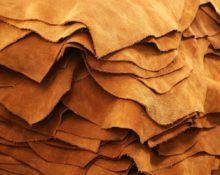Bags made of genuine leather are beautiful, durable, but very expensive. In search of an alternative to natural material, designers turned to polyurethane, which has excellent characteristics. Bags made from this material are very practical, wear-resistant and cheaper than products made from natural raw materials.
What kind of material is polyurethane?
 The German chemist-technologist Bayer Otto Georg Wilhelm synthesized a new polymer in the laboratory in the 30s of the 20th century, called polyurethane. It turned out to be a material with a huge range of applications, and soon its industrial production was established in Germany. Nowadays, such products are widely used in many industries and in everyday life. One such application is sewing bags.
The German chemist-technologist Bayer Otto Georg Wilhelm synthesized a new polymer in the laboratory in the 30s of the 20th century, called polyurethane. It turned out to be a material with a huge range of applications, and soon its industrial production was established in Germany. Nowadays, such products are widely used in many industries and in everyday life. One such application is sewing bags.
What kind of bags are made from polyurethane?
 Recently a new type of polyurethane called PU 100 has appeared. On product labels it is indicated under this name or as polyurethane 100. Sometimes it is positioned as eco-leather.
Recently a new type of polyurethane called PU 100 has appeared. On product labels it is indicated under this name or as polyurethane 100. Sometimes it is positioned as eco-leather.
In fact, this is an excellent imitation of it.The bottom layer really consists of genuine leather, but it has various flaws and tears, and polyurethane is placed on top, which in appearance is indistinguishable from expensive natural raw materials. The advantage of PU leather is increased elasticity, strength, softness, frost resistance, and moisture resistance.
This material inspires famous designers to create their own collections of bags. Global accessory manufacturers use PU leather as the basis for sewing fashionable and stylish handbags that are more practical than natural materials and look great.
Wear resistance of the material
The unique properties of polyurethane allow it to easily replace rubber, rubber, plastic and even metal in many products. Its ability to operate under extreme mechanical loads is used in many industries.
Let us note its positive qualities as a material for sewing bags:
 increased strength and elasticity of PU products;
increased strength and elasticity of PU products;- resistance to deformation, ultraviolet radiation, microorganisms and moisture;
- abrasion resistance and, as a result, low abrasion of the PU surface;
- the highest resistance to aggressive environments: gasoline, various acids, organic solvents and oils do not affect PU leather;
- long service life.
Important! Polyurethane retains its unique properties and demonstrates tremendous wear resistance in the temperature range -60°C to +80°C.
How to care for her?
Synthetic materials do not require as careful care as leather does. Everything is simpler here. Polyurethane is quite undemanding to use and attention is paid to it only periodically.
The main points of caring for a polyurethane bag are as follows:
 surface contamination - if liquids such as tea, coffee, juice, milk are spilled on the bag, or melted ice cream gets on it, then you should simply wipe the area with a damp cloth, and then again with a dry cloth;
surface contamination - if liquids such as tea, coffee, juice, milk are spilled on the bag, or melted ice cream gets on it, then you should simply wipe the area with a damp cloth, and then again with a dry cloth;- in the same way, the bag is cleaned of dust and other fresh contaminants;
- complex stains are removed with ammonia or a solution where technical or medical alcohol and water are taken in a 1:1 ratio. This use of alcohol is possible because the material is synthetic and is not afraid of surface dehydration and drying out, as is the case with leather;
- Old stains of organic origin can be removed using leather cleaners.
Important! To extend the service life of a polyurethane bag, periodically treat its surface with a special water-repellent impregnation for leather products.
How to remove creases from a polyurethane bag?
Improper storage can cause dents and creases on the bag. You can't go anywhere with her like this. We urgently need to look for a panacea for our troubles. There are several ways to get rid of such troubles:
 using a steamer (or an iron with this function). The surface of the bag is processed at a certain distance from the product itself using steam released from a device at a minimum temperature. The resulting condensation is immediately wiped off with a napkin. If the creases are deep, then from the wrong side the heaviest places are processed in the same way.;
using a steamer (or an iron with this function). The surface of the bag is processed at a certain distance from the product itself using steam released from a device at a minimum temperature. The resulting condensation is immediately wiped off with a napkin. If the creases are deep, then from the wrong side the heaviest places are processed in the same way.;- using a steam bath. The bag is suspended for half an hour over a basin of hot water, from the surface of which moisture evaporates. The bruises will go away faster if you place a heavy object inside the product, which will slightly pull the polyurethane down;
- using a press.The surface, slightly moistened and leveled by hand, is covered with a heavy flat object. First, something equally heavy and flat is placed in the bag. The bruises end up between the two layers of the press. Let sit for several hours, checking occasionally for readiness. Dry naturally;
- using oil. Folds treated with Vaseline, glycerin or castor oil will become softer and gradually, within a couple of days, straighten out. This technique will improve the overall appearance of the product. Treatment is carried out not only in places of creases, but also on the entire surface. The product should be left for several hours to be absorbed, after which the final stage is to polish the surface with a woolen or velvet cloth.


 increased strength and elasticity of PU products;
increased strength and elasticity of PU products; surface contamination - if liquids such as tea, coffee, juice, milk are spilled on the bag, or melted ice cream gets on it, then you should simply wipe the area with a damp cloth, and then again with a dry cloth;
surface contamination - if liquids such as tea, coffee, juice, milk are spilled on the bag, or melted ice cream gets on it, then you should simply wipe the area with a damp cloth, and then again with a dry cloth; using a steamer (or an iron with this function). The surface of the bag is processed at a certain distance from the product itself using steam released from a device at a minimum temperature. The resulting condensation is immediately wiped off with a napkin. If the creases are deep, then from the wrong side the heaviest places are processed in the same way.;
using a steamer (or an iron with this function). The surface of the bag is processed at a certain distance from the product itself using steam released from a device at a minimum temperature. The resulting condensation is immediately wiped off with a napkin. If the creases are deep, then from the wrong side the heaviest places are processed in the same way.; 0
0





